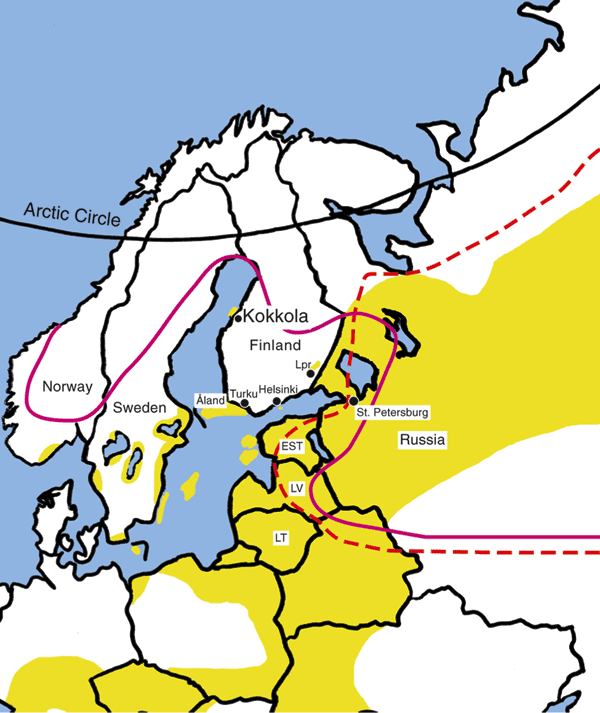Volume 12, Number 10—October 2006
Dispatch
Siberian Subtype Tickborne Encephalitis Virus, Finland
Figure 1

Figure 1. The known distribution of tickborne encephalitis (TBE)–virus endemic areas and Ixodes ticks in northern Europe. Yellow: TBE-endemic areas, adapted from International Scientific Working Group on Tick-Borne Encephalitis (8). To the south and west from the solid line, Ixodes ricinus distribution; to the east from the dashed line, I. persulcatus distribution; Lpr, Lappeenranta; EST, Estonia; LV, Latvia; LT, Lithuania.
References
- Ecker M, Allison SL, Meixner T, Heinz FX. Sequence analysis and genetic classification of tick-borne encephalitis viruses from Europe and Asia. J Gen Virol. 1999;80:179–85.PubMedGoogle Scholar
- Hayasaka D, Ivanov L, Leonova GN, Goto A, Yoshii K, Mizutani T, Distribution and characterization of tick-borne encephalitis viruses from Siberia and far-eastern Asia. J Gen Virol. 2001;82:1319–28.PubMedGoogle Scholar
- Lundkvist K, Vene S, Golovljova I, Mavtchoutko V, Forsgren M, Kalnina V, Characterization of tick-borne encephalitis virus from Latvia: evidence for co-circulation of three distinct subtypes. J Med Virol. 2001;65:730–5. DOIPubMedGoogle Scholar
- Charrel RN, Attoui H, Butenko AM, Clegg JC, Deubel V, Frolova TV, Tick-borne virus diseases of human interest in Europe. Clin Microbiol Infect. 2004;10:1040–55. DOIPubMedGoogle Scholar
- Golovljova I, Vene S, Sjolander KB, Vasilenko V, Plyusnin A, Lundkvist Å. Characterization of tick-borne encephalitis virus from Estonia. J Med Virol. 2004;74:580–8. DOIPubMedGoogle Scholar
- Jaenson TG, Talleklint L, Lundqvist L, Olsen B, Chirico J, Mejlon H. Geographical distribution, host associations, and vector roles of ticks (Acari: Ixodidae, Argasidae) in Sweden. J Med Entomol. 1994;31:240–56.PubMedGoogle Scholar
- Öhman C. The geographical and topographical distribution of Ixodes ricinus in Finland. Acta Societatis Pro Fauna et Flora Fennica. 1961;76:1–25.
- International Scientific Working Group on Tick-Borne Encephalitis. 2006 Jan 11 [cited 2006 Mar 14]. Available from http://www.tbe-info.com/tbe.aspx
- Wahlberg P, Saikku P, Brummer-Korvenkontio M. Tick-borne viral encephalitis in Finland. The clinical features of Kumlinge disease during 1959–1987. J Intern Med. 1989;225:173–7. DOIPubMedGoogle Scholar
- Tuomi J, Brummer-Korvenkontio M. Antibodies against viruses of the tick-borne encephalitis group in cattle sera in Finland. Ann Med Exp Biol Fenn. 1965;43:149–54.PubMedGoogle Scholar
- Marjelund S, Tikkakoski T, Tuisku S, Räisänen S. Magnetic resonance imaging findings and outcome in severe tick-borne encephalitis. Report of four cases and review of the literature. Radiol. 2004;45:88–94.PubMedGoogle Scholar
- Marjelund S, Jääskeläinen A, Tikkakoski T, Tuisku S, Vapalahti O. Gadolinium enhancement of the cauda equina—a new MR imaging finding in a myeloradiculitic form of tick-borne encephalitis. AJNR Am J Neuroradiol. 2006;27:995–7.PubMedGoogle Scholar
- Puchhammer-Stöckl E, Kunz C, Mandl CW, Heinz FX. Identification of tick-borne encephalitis virus ribonucleic acid in tick suspensions and in clinical specimens by a reverse transcription-nested polymerase chain reaction assay. Clin Diagn Virol. 1995;4:321–6. DOIPubMedGoogle Scholar
- Caporale DA, Rich SM, Spielman A, Telford SR III, Kocher TD. Discriminating between Ixodes ticks by means of mitochondrial DNA sequences. Mol Phylogenet Evol. 1995;4:361–5. DOIPubMedGoogle Scholar
- Han X, Aho M, Vene S, Peltomaa M, Vaheri A, Vapalahti O. Prevalence of tick-borne encephalitis virus in Ixodes ricinus ticks in Finland. J Med Virol. 2001;64:21–8. DOIPubMedGoogle Scholar
Page created: November 10, 2011
Page updated: November 10, 2011
Page reviewed: November 10, 2011
The conclusions, findings, and opinions expressed by authors contributing to this journal do not necessarily reflect the official position of the U.S. Department of Health and Human Services, the Public Health Service, the Centers for Disease Control and Prevention, or the authors' affiliated institutions. Use of trade names is for identification only and does not imply endorsement by any of the groups named above.